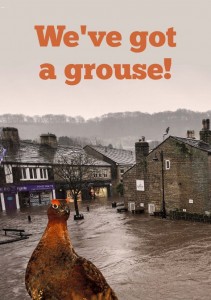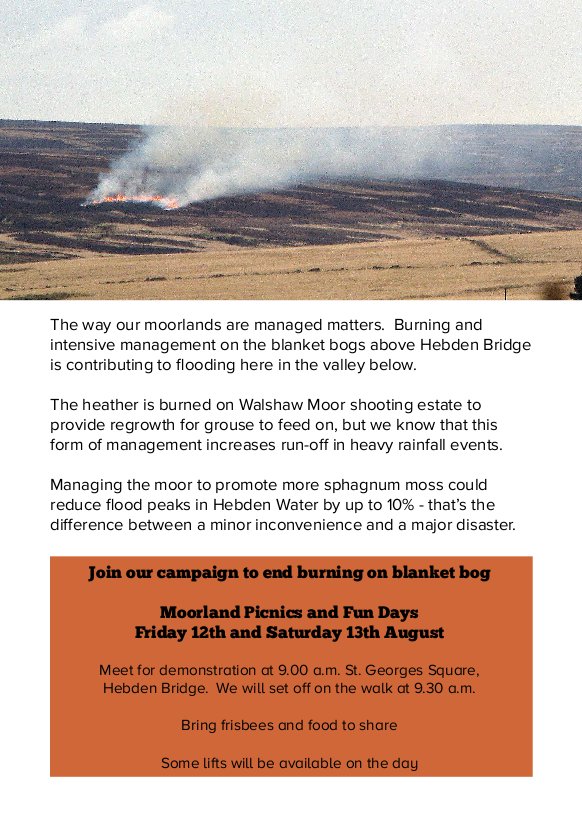Hebden Bridge people will gather in St Georges Square at 9am on 12th and 13th August to protest the not-so-glorious 12th August, traditionally the start of the grouse shooting season.
It is widely accepted that mismanagement of the Walshaw Moor blanket bogs for intensive grouse rearing has contributed to three severe floods in Hebden Bridge over the last four years, and downstream in the Calder Valley.
Some households and businesses have still not recovered from the terrible Boxing Day flood last year, when the town centre was under up to five feet of filthy water.
Following the protest, everyone is welcome to walk up to the Moor (lifts are available to an assembly point at the edge of the moor for those who can’t face that distance – about an hour and a half to two hours walk) for a picnic and fun day that will include simple citizen ecology projects suitable for children and adults. This will help establish whether and how the blanket bog is regenerating or not.
On Saturday, the 906 bus runs. This leaves New Road at 11.19 and arrives at Blake Dean at 11.39. It goes via Heptonstall Road, so some might want to pick it up at Mytholm at around 11.21
From the assembly point near Blake Dean around midday, the moorland walk will take about 90 minutes there and 90 minutes back, with around an hour or so in the middle for picnic, fun and ecology monitoring. People are welcome to walk for as little or far as they like. For those who go the whole distance, we expect to be off the moor by about 4pm.
If you would like to come on the walk, please wear sensible waterproof shoes or boots, bring raincoats, food for shared picnic and water. More info will be available at the protest at St George’s Square, which will carry on for about 30 – 40 minutes. If you bring a dog, please make sure to keep it on a lead at all times when on the moor.
Protesters are calling for Richard Bannister, the owner of Walshaw Moor Estate, to urgently take ecological conservation and restoration measures that will significantly reduce peak flow in Hebden Water.
Although as an EU Natura 2000 site Walshaw Moor has the highest possible level of environmental protection, the landowner’s agreement with Natural England permits so-called “cool burning of heather, as well as extensive track building and draining within 50 metres of the many grouse shooting butts.
Supported by £2.5m of taxpayer subsidies via Environmental Stewardship payments for “restoring” the moors, the owner of Walshaw Moor, Richard Bannister leaves vast swathes of precious peatland scarred with vehicle tracks and drained and burnt dry – although the permitted “cool burning’ is supposed not to damage the sphagnum moss that grows on moorland peat and is vital for the survival of the blanket bog.
This is all so that unnaturally large populations of red grouse can be nurtured as live targets for ‘guns’.
 Leeds University research, led by Dr Lee Brown and published in 2014, confirms Ban the Burn campaigners’ criticisms of the Walshaw Moor Estate burning. In all areas that the Leeds University researchers looked at over a period of five years, cool burning destroyed the sphagnum moss and left bare peat.
Leeds University research, led by Dr Lee Brown and published in 2014, confirms Ban the Burn campaigners’ criticisms of the Walshaw Moor Estate burning. In all areas that the Leeds University researchers looked at over a period of five years, cool burning destroyed the sphagnum moss and left bare peat.
It also lowered the water table so the peat dried out, oxidised and became a source of net carbon loss – rather than a net carbon uptake through taking CO2 out of the atmosphere and sinking it into the peat. This worsens climate change.
Dr Joseph Holden’s 2015 update to this research confirmed that the destruction of the sphagnum by permitted burning on blanket bog also increased the amount and speed of water runoff during the worst 20% of storms, so increasing the risk of flooding in areas below the moors.
In response to a complaint from local residents’ group Ban the Burn, the European Commission has started a legal process against the UK government for:
- the failure to carry out appropriate assessments on the Walshaw Moor Estate in the South Pennines Natura 2000 site, and other Natura 2000 sites, as required under the EU Habitats Directive in relation to a number of management agreements
allowing burning of blanket bogs within the Natura 2000 sites - the failure to avoid deterioration of blanket bog habitats within those sites in England
The UK government had two months to respond to the EU Commission letter, which was sent on 29th April 2016. This is the first step in a legal process. But with the UK vote to leave the EU, Yorkshire and Humberside MEP Linda McAvan has said it is unclear whether the European Commission is following up the process.
Hebden Bridge residents are determined to keep up the pressure to protect and restore the rare and valuable blanket bog and in doing so, to reduce the flood risk to the town and the downstream Calder Valley.
